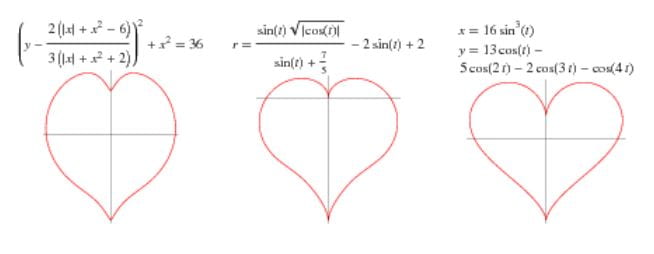Valentine’s Day is one of the most widely celebrated holidays on our calendar. The whole school, parking lot, neighborhood, (basically everywhere) seems to be filled with flurries of red and pink hearts, chocolates, and cherubs. We have many diverse and popular holidays, but apparently, on Valentine’s Day, we can “feel the love in the air”, and most people either hate Valentine’s Day or love it.
I find Valentine’s Day to be special, but not because it’s the day of love.
Drawn on every card, molded into every decoration, and written into every declaration of love is one shape: the heart. Rather than the day of love, doesn’t Valentine’s Day seem like the day of heart shapes? There seem to be more hearts than love when we walk along the streets. A whole day dedicated to one specific shape… triangles and circles are probably jealous.
So it’s no wonder that there are so many math and science analogies to love, since it’s right up a mathematician or scientist’s alley. And when we see shapes, we always think of equations to recreate them. Just like there are many types of heart shapes, there are many ways to graph the equation of the heart.
This heart above is graphed by the equation (x^2 + y^2 – 1)^3 = x^2 y^3. As we can see, the heart is enlarged by changing the constant to something larger, and made smaller by changing the constant to something smaller. However, this equation only seems to work when the constant is positive.
What about other heart equations?
The cardioid, shown in the graph above, is a mathematician’s favorite because we see it often in our day-to-day lives, like in the example of the cup above! Formed by (x^2 + y^2 + a x)^2 = a^2(x^2 + y^2), the cardioid is known to be a special case of an epicycloid, shown below, which is created by rolling around a circle around the circumference of another circle.
Depicted above are other equations that can be used to create the heart shape.
If you want to learn more about other equations to create more heart shapes or how hearts can be created using other shapes, crafts, and architectural designs, you can visit http://www.mathematische-basteleien.de/heart.htm to learn more!
written by Saanvi Gutta
edited by Keerthi Selvam and Tryphena Pilli
REFERENCES:
Heart Curve. Mathematische Basteleien. http://www.mathematische-basteleien.de/heart.htm
Lewis, H. (2018, February 1). Valentine’s Day Maths: What is the equation for a heart? Maths Careers. https://www.mathscareers.org.uk/valentines-day-maths-what-is-the-equation-for-a-heart/
IMAGE SOURCES:
Heart Curve [Graph]. Wolfram MathWorld. https://mathworld.wolfram.com/HeartCurve.html
Epicycloid [Graph]. Maths Careers. https://www.mathscareers.org.uk/valentines-day-maths-what-is-the-equation-for-a-heart/
Cardioid [Photograph]. Maths Careers. https://www.mathscareers.org.uk/valentines-day-maths-what-is-the-equation-for-a-heart/
[Love candy by heart background] [Photograph]. By Design. https://www.ftd.com/blog/celebrate/valentines-day-puns
Note: The first heart and cardioid were graphed (by me) using Desmos, an online graphing calculator that can be accessed through your LCPS Go.






Very helpful information
Excellent knowledge.
Hands off to you.
👐
Valencia